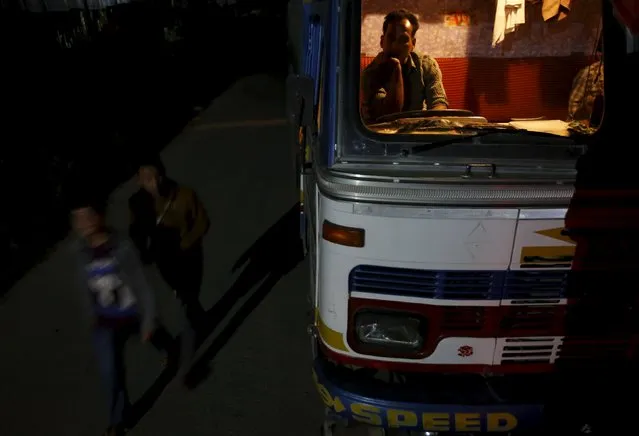
A driver sits inside a cabin of a petrol tanker as he waits at a queue to fill petrol in his tanker during an ongoing fuel crisis in Kathmandu, Nepal November 2, 2015. (Photo by Navesh Chitrakar/Reuters)
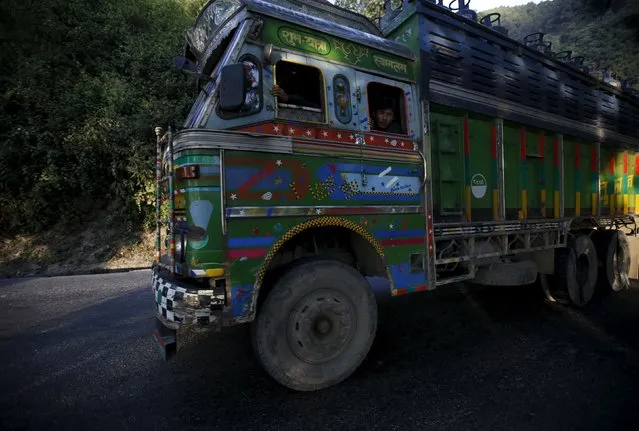
A truck carrying cooking gas cylinders enters through Prithivi highway, during an ongoing fuel crisis, in Kathmandu, Nepal November 2, 2015. (Photo by Navesh Chitrakar/Reuters)
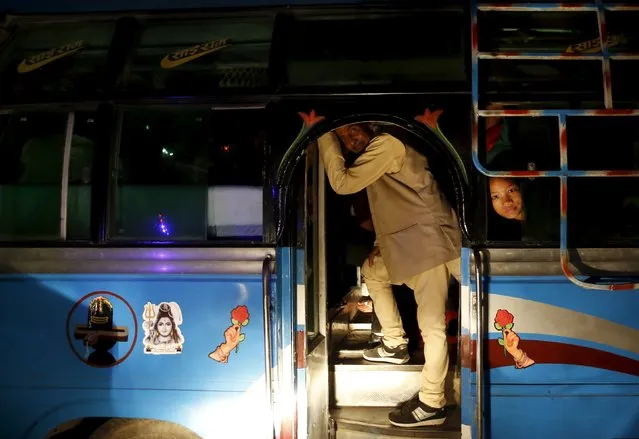
Passengers ride on an overcrowded bus, amidst limited public transportation in the city, during an ongoing fuel crisis in Kathmandu, Nepal November 2, 2015. (Photo by Navesh Chitrakar/Reuters)
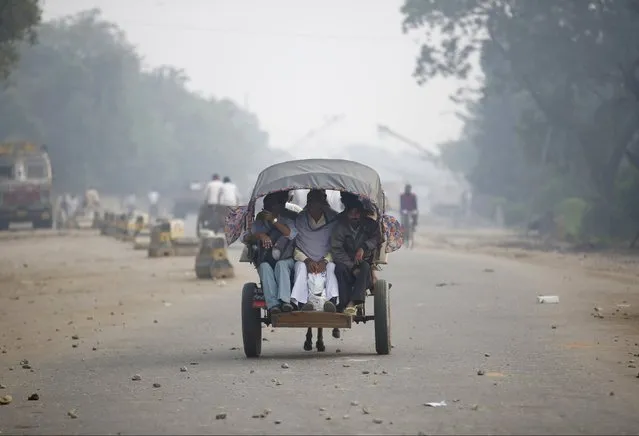
Passengers ride on a cart as they arrive from India, at the Nepalese-Indian border during a general strike called by Madhesi protesters demonstrating against the new constitution in Birgunj, Nepal November 5, 2015. (Photo by Navesh Chitrakar/Reuters)
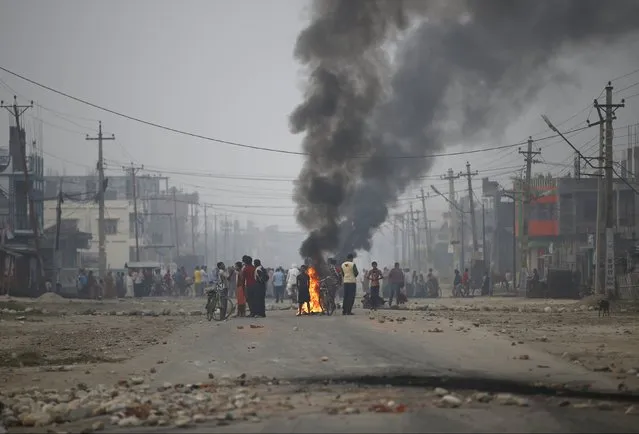
Protesters stand near burning tyres as they gather to block the highway connecting Nepal and India, during a general strike called by Madhesi protesters demonstrating against the new constitution in Birgunj, Nepal November 5, 2015. Nepal has faced an acute fuel crisis for more than a month since protesters in the lowland south, angered that a new constitution fails to reflect their interests, prevented supply trucks from entering from India. Many in Nepal see India's hand in the protests although it denies any role. (Photo by Navesh Chitrakar/Reuters)
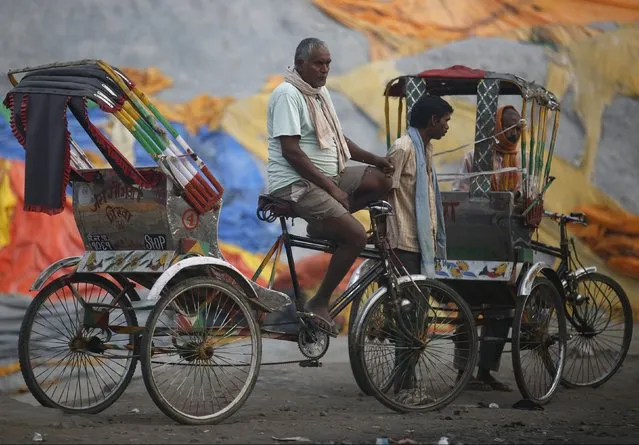
Rickshaw drivers wait for passengers at the Nepalese-Indian border during a general strike called by Madhesi protesters demonstrating against the new constitution in Birgunj, Nepal November 5, 2015. (Photo by Navesh Chitrakar/Reuters)
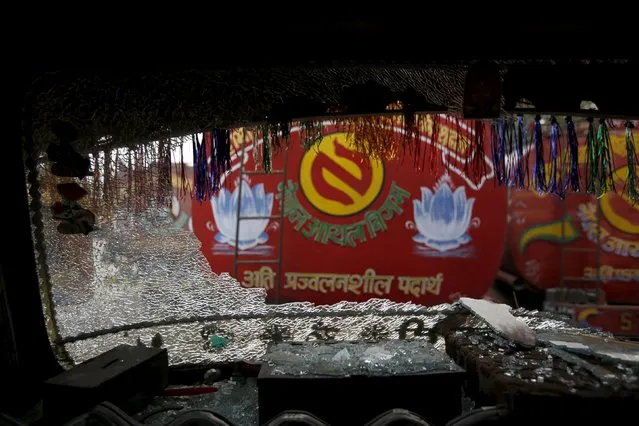
A vandalised windshield is pictured on a petrol tanker parked at customs at the Nepalese-Indian border during general strike called by Madhesi protesters demonstrating against the new constitution in Birgunj, Nepal November 5, 2015. (Photo by Navesh Chitrakar/Reuters)
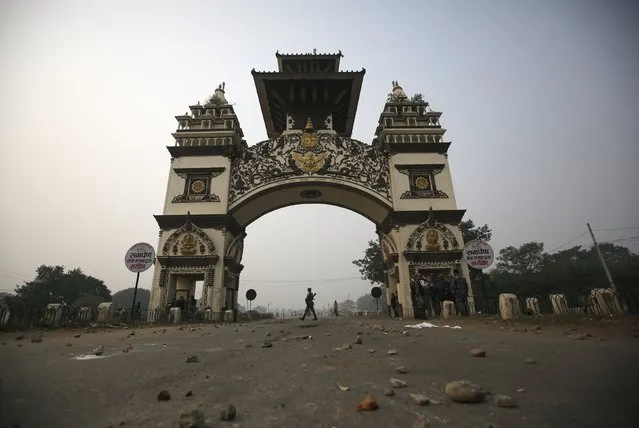
A member of the Nepalese Armed Police Force walks along the Shankaracharya Gate at the Nepalese-Indian border, as stones thrown by the protesters are scattered on the road during a general strike called by Madhesi protesters demonstrating against the new constitution in Birgunj, Nepal November 5, 2015. (Photo by Navesh Chitrakar/Reuters)
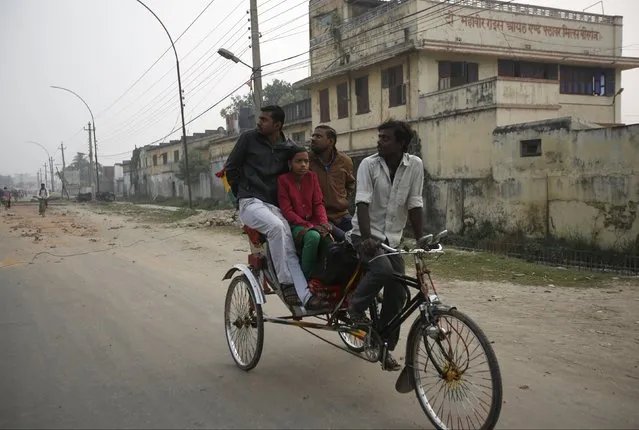
People head towards the Nepalese-Indian border on a rickshaw during a general strike called by Madhesi protesters demonstrating against the new constitution in Birgunj, Nepal November 5, 2015. (Photo by Navesh Chitrakar/Reuters)
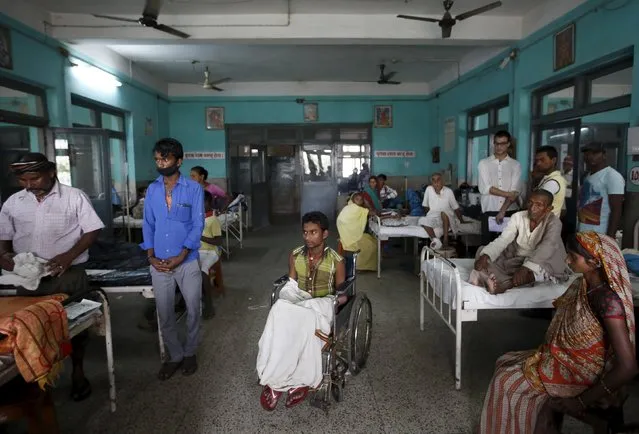
Madhesi protester Manoj Paswan (C), who accidently burned himself during a protest, sits in a wheelchair at a hospital in Birgunj, Nepal November 5, 2015. (Photo by Navesh Chitrakar/Reuters)
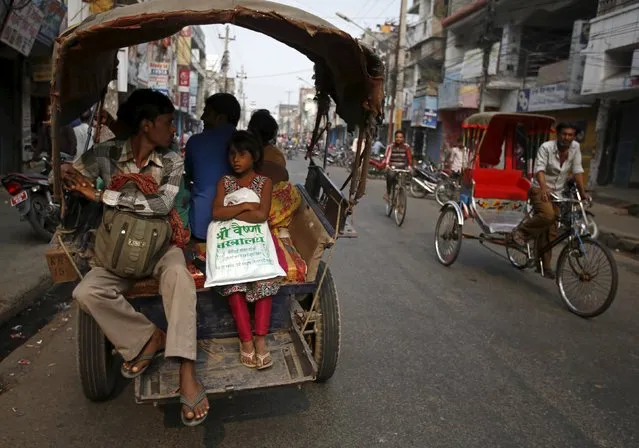
People travel on a cart as the market opens after the curfew is lifted in Birgunj, Nepal November 5, 2015. (Photo by Navesh Chitrakar/Reuters)
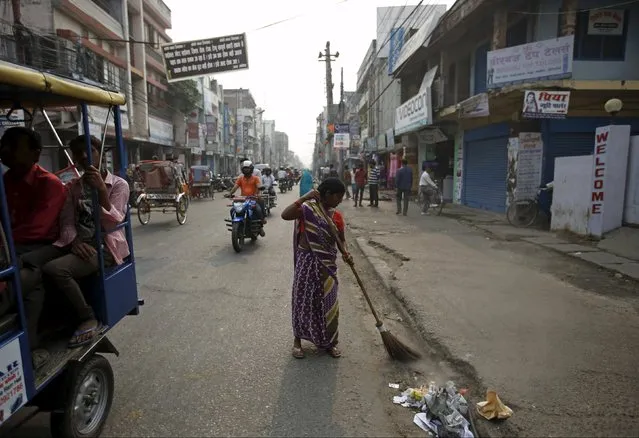
A woman sweeps the road after the curfew is lifted in Birgunj, Nepal November 5, 2015. (Photo by Navesh Chitrakar/Reuters)
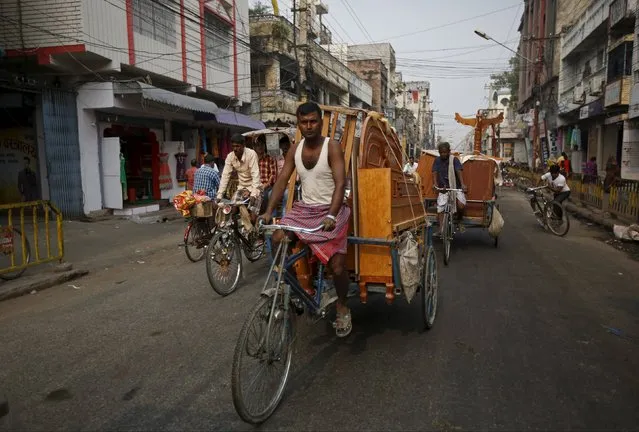
Rickshaw drivers transport furniture as the market opens after the curfew is lifted in Birgunj, Nepal November 5, 2015. (Photo by Navesh Chitrakar/Reuters)
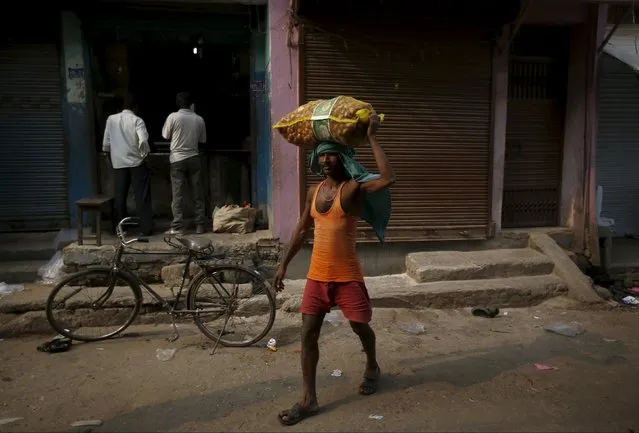
A man carries a sack of onions at the market after the curfew is lifted in Birgunj, Nepal November 5, 2015. (Photo by Navesh Chitrakar/Reuters)
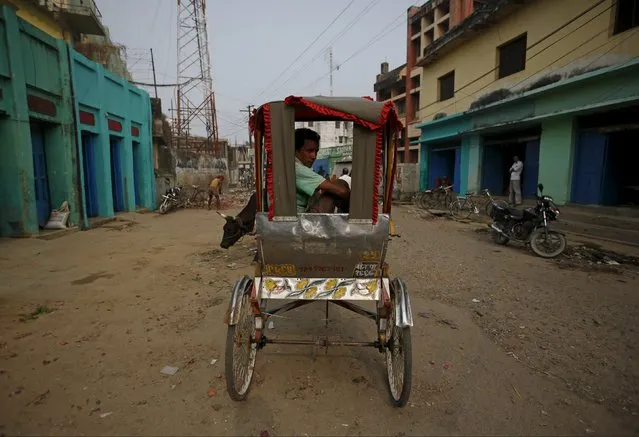
A rickshaw driver sits on his rickshaw as he waits for customers at the market after the curfew is lifted in Birgunj, Nepal November 5, 2015. (Photo by Navesh Chitrakar/Reuters)
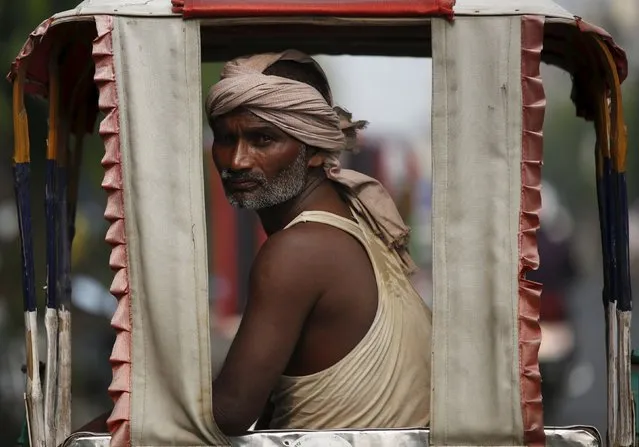
A rickshaw driver sits on his rickshaw as he waits for customers at the market after the curfew is lifted in Birgunj, Nepal November 5, 2015. (Photo by Navesh Chitrakar/Reuters)
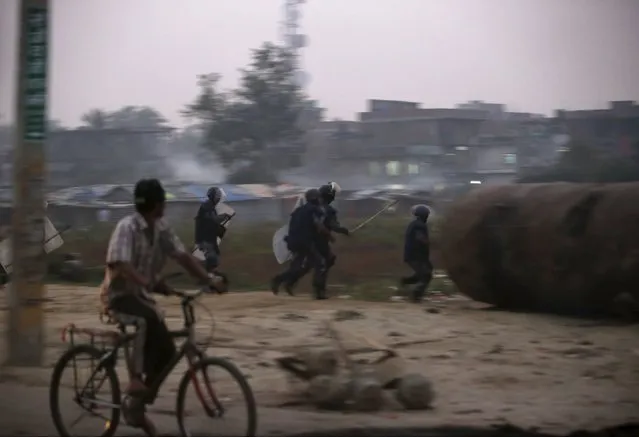
Nepalese police personnel chase Madhesi protesters (unseen) demonstrating against the new constitution in Birgunj, Nepal November 5, 2015. (Photo by Navesh Chitrakar/Reuters)
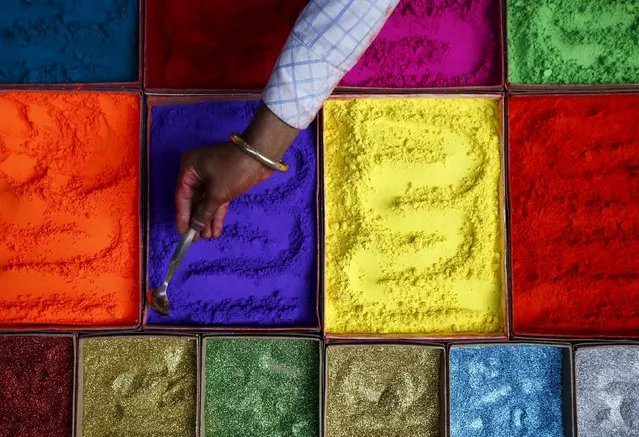
A street vendor spreads vermilion powder used for worship during the Tihar festival, also called Diwali in Kathmandu, Nepal, November 9, 2015. Hindus all over Nepal are celebrating the Tihar festival during which they worship cows, which are considered a maternal figure, and other animals. Also known as the festival of lights, devotees also worship the goddess of wealth Laxmi by illuminating and decorating their homes using garlands, oil lamps, candles and colourful light bulbs. (Photo by Navesh Chitrakar/Reuters)
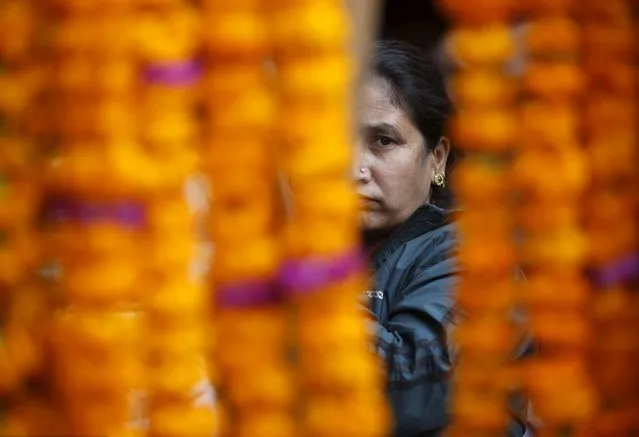
A vendor sells garlands along the streets of Kathmandu during the Tihar festival also called Diwali in Kathmandu, Nepal, November 9, 2015. (Photo by Navesh Chitrakar/Reuters)
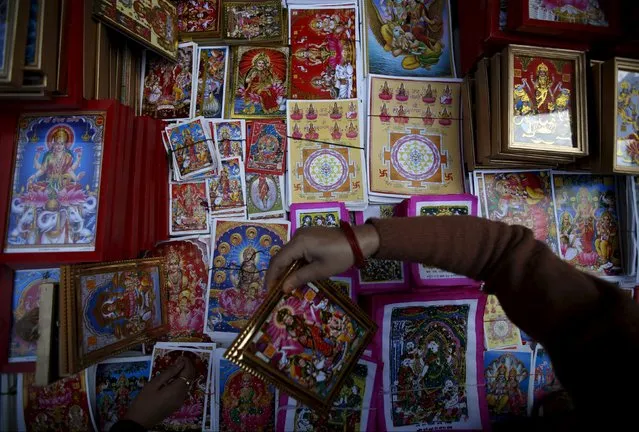
Posters of the Goddess of Wealth, Laxmi is seen on sale by a vendor along the streets of Kathmandu, Nepal, November 9, 2015. (Photo by Navesh Chitrakar/Reuters)
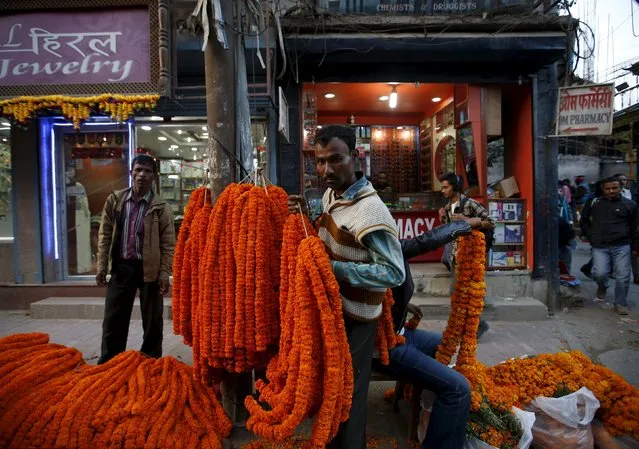
A vendor (C) sells garlands along the streets of Kathmandu during the Tihar festival, also called Diwali, in Kathmandu, Nepal, November 10, 2015. (Photo by Navesh Chitrakar/Reuters)
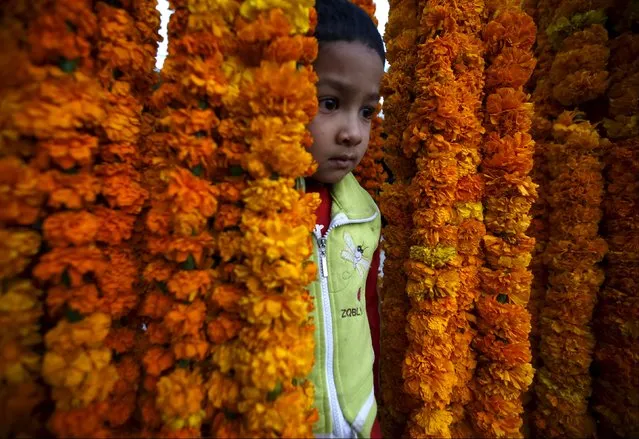
A boy stands in between the garlands kept on sale along the streets of Kathmandu during the Tihar festival, also called Diwali, in Kathmandu, Nepal, November 10, 2015. (Photo by Navesh Chitrakar/Reuters)
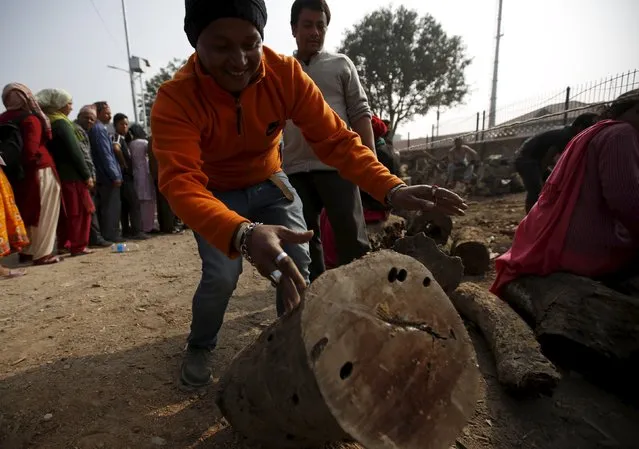
A man buys firewood from a government depot after the government started selling it from Sunday, as a respite for the ongoing fuel and cooking gas shortages in Kathmandu, Nepal November 16, 2015. The middle hills and the capital Kathmandu have suffered fuel and cooking gas shortages after protesters in the south switched to blocking supplies from India, Nepal's largest trading partner, almost two months ago. (Photo by Navesh Chitrakar/Reuters)
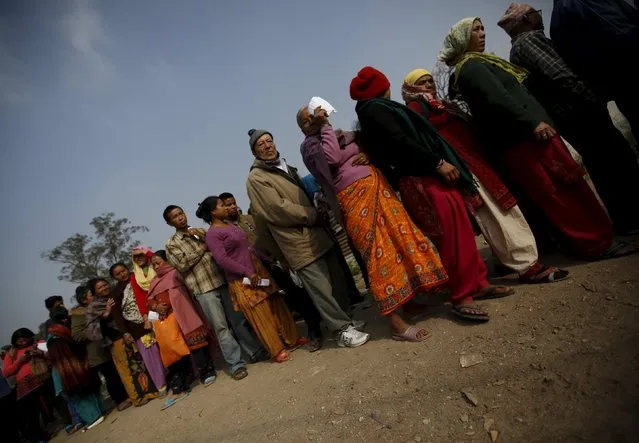
People queue to buy firewood from a government depot after the government started selling it to the public from Sunday, as a respite for the ongoing fuel and cooking gas shortages in Kathmandu, Nepal November 16, 2015. (Photo by Navesh Chitrakar/Reuters)
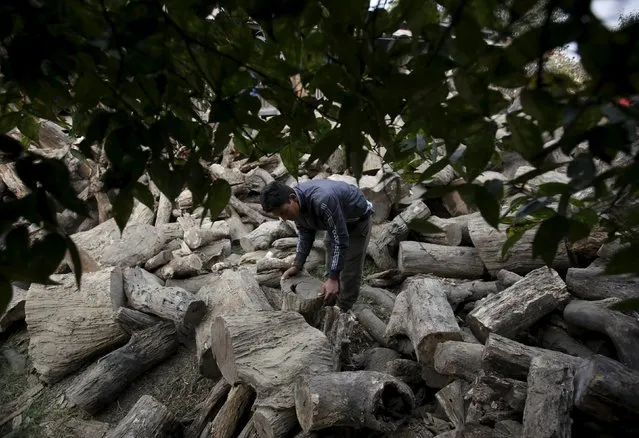
A man buys firewood at a government depot after the government started selling it to the public from Sunday, as a respite for the ongoing fuel and cooking gas shortages in Lalitpur, Nepal November 16, 2015. (Photo by Navesh Chitrakar/Reuters)
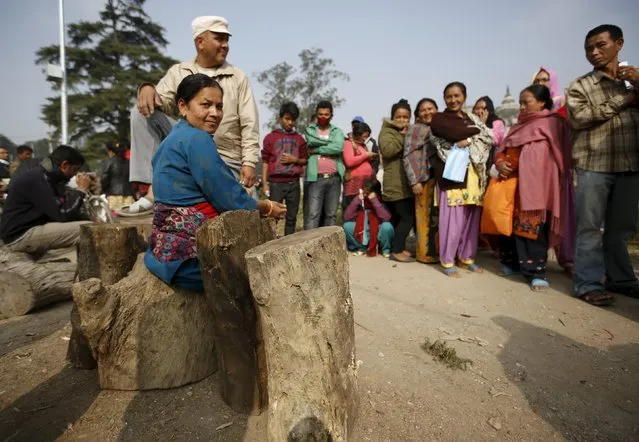
People queue to buy firewood from a government depot after the government started selling it to the public from Sunday, as a respite for the ongoing fuel and cooking gas shortages in Kathmandu, Nepal November 16, 2015. (Photo by Navesh Chitrakar/Reuters)
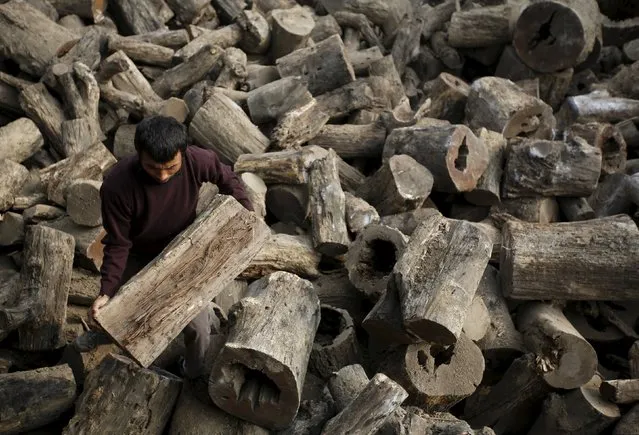
A man buys firewood at a government depot after the government started selling it to the public from Sunday, as a respite for the ongoing fuel and cooking gas shortages in Lalitpur, Nepal November 16, 2015. (Photo by Navesh Chitrakar/Reuters)
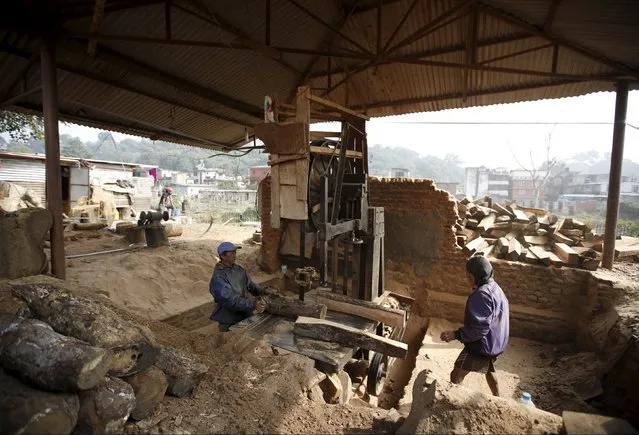
Workers cut firewood to be sold for cremation ceremonies at the Pashupatinath Temple in Kathmandu, Nepal November 16, 2015. (Photo by Navesh Chitrakar/Reuters)
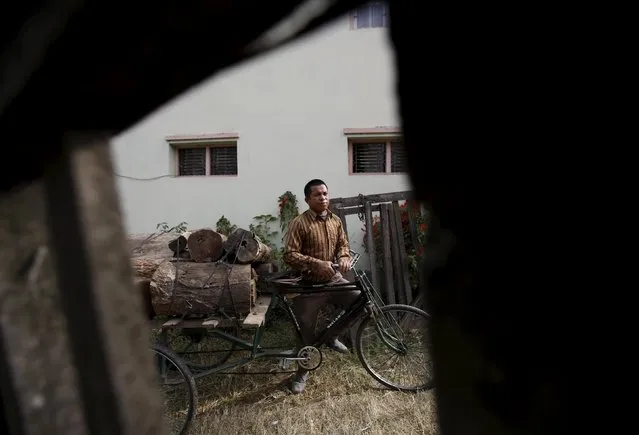
A man stands near his rickshaw loaded with firewood after buying them from a government depot in Lalitpur, Nepal November 16, 2015. The government started selling firewood to the public from Sunday, as a respite for the ongoing fuel and cooking gas shortages. (Photo by Navesh Chitrakar/Reuters)
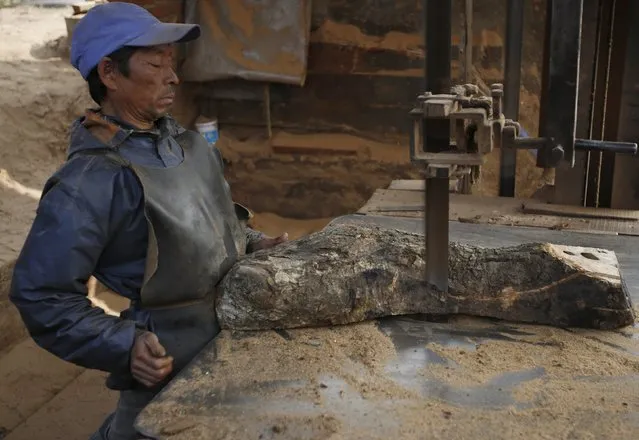
A worker cut firewood to be sold for cremation ceremonies at the Pashupatinath Temple in Kathmandu, Nepal November 16, 2015. (Photo by Navesh Chitrakar/Reuters)
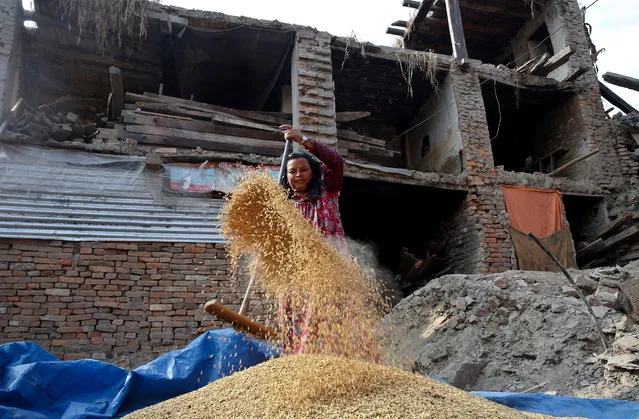
A Nepalese farmer winnows rice before taking it to market, in front of her home destroyed in the 25 April earthquake, in one of the areas worst affected by the quake, Bhaktapur, on the outskirts of Kathmandu, Nepal, 16 November 2015. Agriculture remains Nepal's principal economic activity, employing over 71 per cent of the population and providing 32.12 per cent of GDP. Rice and wheat are the main food crops of Nepal, according to Government data. (Photo by Narendra Shrestha/EPA)
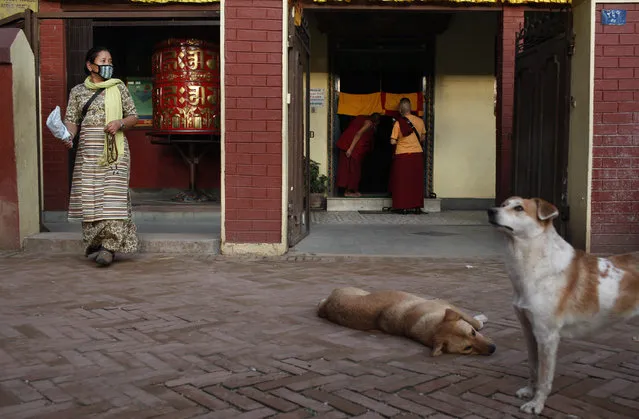
A Nepalese Buddhist woman, left, walks out from a monastery near the Boudhanath Stupa in Kathmandu, Nepal, Tuesday, September 22, 2015. While many in Nepal cheered Sunday's adoption of a permanent constitution after a 10-year effort, some ethnic groups say their concerns that the seven newly defined states would have borders cutting through their ethnic homelands were ignored. (Photo by Niranjan Shrestha/AP Photo)
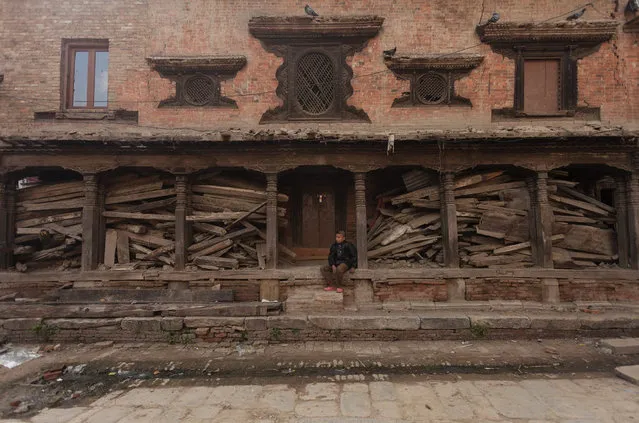
A Nepalese boy sits in front of an earthquake damaged house, half a year after the great earthquake hit the country, in Bhaktapur, Nepal, 25 October 2015. Six months after devastating twin earthquakes struck Nepal, thousands of people are still struggling in temporary shelters and dire conditions. A magnitude-7.8 earthquake on 25 April killed nearly 9,000 people and destroyed hundreds of thousands of houses. (Photo by Hemanta Shrestha/EPA)
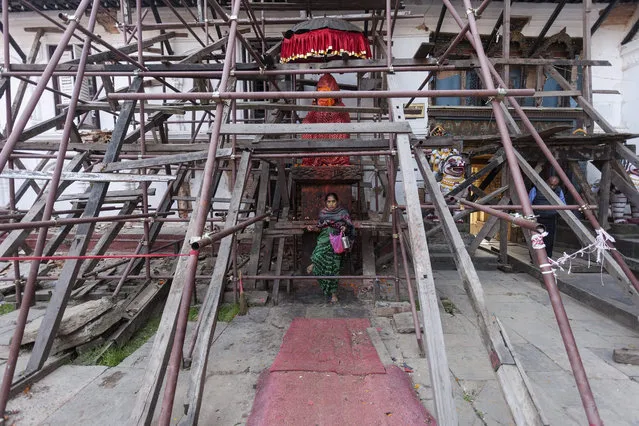
A Hindu Nepalese woman participates in early morning prayer at the earthquake damaged Lord Hanuman Temple, which is supported by iron rod and wood beams, in Basantapur Darabar Square area, Kathmandu, Nepal, 26 October 2015. (Photo by Hemanta Shrestha/EPA)
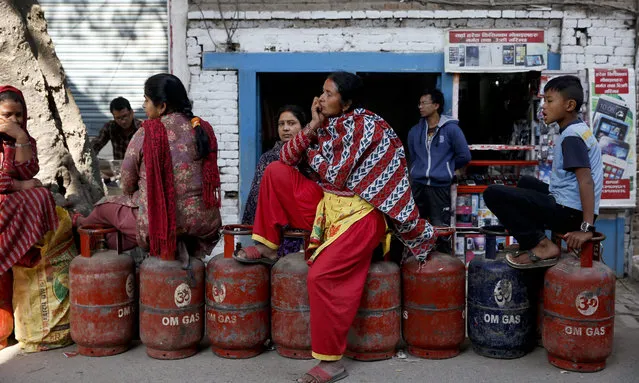
Nepalese households wait in a queue with their empty cooking gas cylinders for fresh supply in Kathmandu, Nepal, 03 November 2015. India, which supplies all of Nepal's fuel, closed its border with its neighbor 40 days ago, citing the danger posed by the anti-constitution protests. As a result, Nepal's fuel supplies have dried up, causing a scarcity of cooking gas and petrol. (Photo by Narendra Shrestha/EPA)
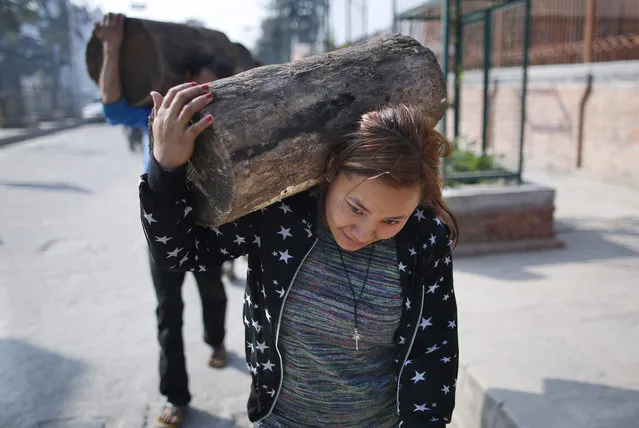
Nepalese households carry firewood on their backs in Kathmandu, Nepal, 15 November 2015. The Nepal government was to sell firewood to the public from 15 November to ease the fuel crisis situation, authorities said. Nepal is facing fuel shortages due to a border blockade by India, which cites anti-constitution protests in the southern Terai region over the past three months. The state-run Timber Corporation, part of the Forest Ministry, was to sell the firewood from its depots across the country at 15 Nepalese Rupee (14 cents of US dollar) per kilogram, limited to 100 kilogram per family. The Timber Corporation is responsible for selling low-quality timber that cannot be used for construction or furniture. The wood is collected from community and government-owned forests across the country and sold for burning, including cremations. The government also distributes free firewood in some districts during winter for bonfires. According to government figures, 64 percent of Nepal's households still use firewood for cooking, with more turning to the fuel source since deliveries of cooking gas and kerosene from India stopped. (Photo by Narendra Shrestha/EPA)
18 Nov 2015 08:05:00,
post received
0 comments
